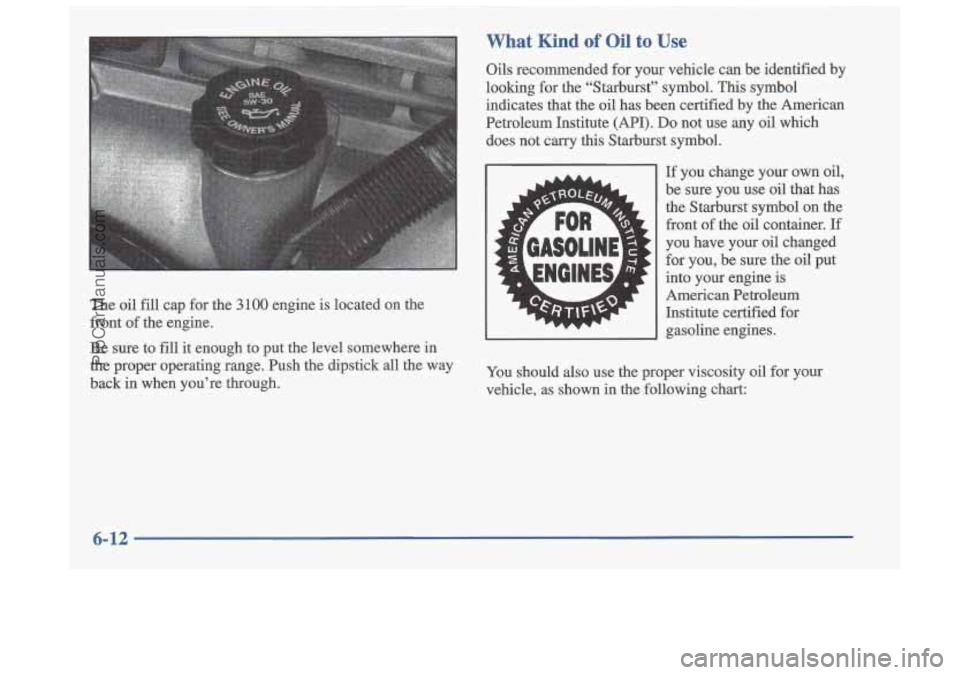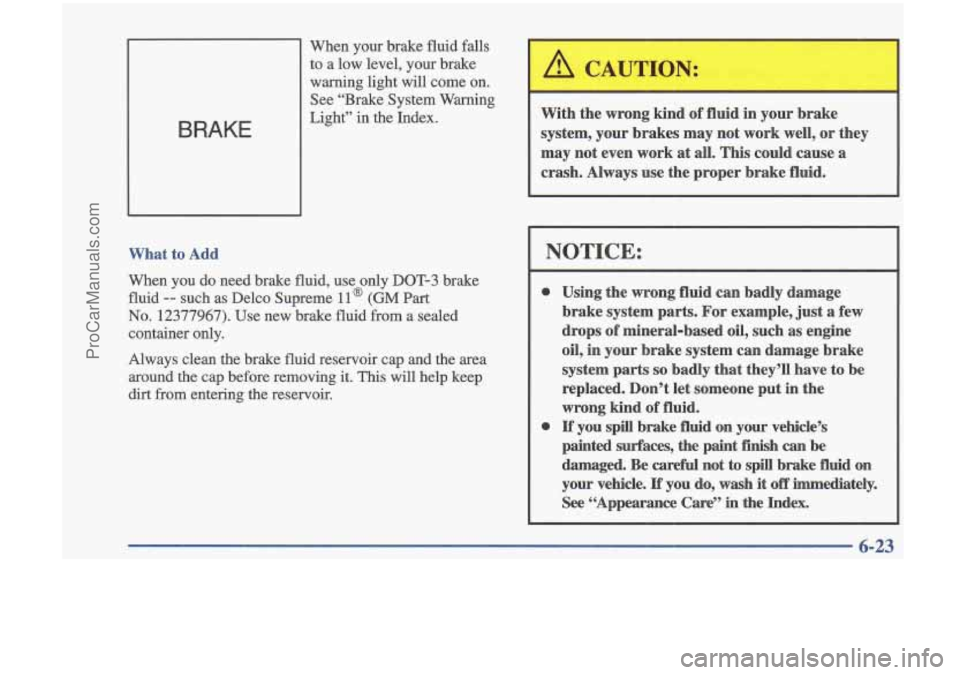1997 OLDSMOBILE CUTLASS oil level
[x] Cancel search: oil levelPage 116 of 353

Check Oil Light Passlock Warning Light
CHECK
OIL
If the light
comes on and
you hear a chime or stays on after starting your vehicle,
your engine oil level should
be checked.
THEFT
SYSTEM
This light will come on
briefly when
you turn
the ignition on. The light
will stay on until the
engine
starts.
Prior to checking the oil level, be sure your vehicle has
been shut
off for several minutes and is on a level
surface. Check the oil level on your dipstick and bring
it to the proper level. See “Engine Oil” in the Index.
NOTE:
A false CHECK OIL light may be generated
when parking on steep grades.
The oil level monitoring system only checks oil level
during the brief period between key on and engine
crank.
It does not monitor engine oil level when the
engine is running. Additionally, an oil level check is
only performed if the engine has been turned
off for a
considerable period
of time allowing the oil normally in
circulation
to drain back into the oil pan.
If the light flashes for several seconds, the Passlock
system has entered a tamper mode.
If the vehicle fails
to start, see “Passlock” in the Index.
If the light comes on continuously while driving and
stays on, there may be a problem with the Passlock
system.
Your vehicle will not be protected by Passlock,
and you should see your retailer.
ProCarManuals.com
Page 166 of 353

The exit speed is usually posted.
Reduce your speed according to your speedometer, not
to your sense of motion. After driving for any distance
at higher speeds, you may tend to think you are going
slower than you actually are.
Before Leaving on a Long Trip
Make sure you’re ready. Try to be well rested. If you
must start when you’re not fresh
-- such as after a day’s
work
-- don’t plan to make too many miles that first part
of the journey. Wear comfortable clothing and shoes you
can easily drive
in.
Is your vehicle ready for a long trip? If you keep it
serviced and maintained, it’s ready to
go. If it needs
service, have it done before starting out. Of course,
you’ll find experienced and able service experts in
Oldsmobile retail facilities all across North America.
They’ll be ready and willing to help
if you need it. Here are some things you
can check before a trip:
0
0
0
0
0
0
0
Windshield Washer Fluid: Is the reservoir full? Are
all windows clean inside and outside?
Wiper Blades: Are they in good shape?
Fuel, Engine Oil, Other Fluids: Have you checked
all levels?
Lamps: Are they all working? Are the lenses clean?
Tires: They are vitally important to a safe,
trouble-free trip. Is the tread good enough for
long-distance driving? Are the tires all inflated to the
recommended pressure?
Weather Forecasts: What’s the weather outlook
along your route? Should you delay your trip a
short
time to avoid a major storm system?
Maps: Do you have up-to-date maps?
ProCarManuals.com
Page 224 of 353

Section 6 Service and Appearance Care
Here you will find information about the care of your Oldsmobile. This section begins with service and fuel
information, and then it shows how to check important fluid an\
d lubricant levels. There is also technical information
about your vehicle, and a part devoted to its appearance care.\
6-2 6-3
6-5
6-5 6-7
6-11 6- 16
6-16
6-21
6-22
6-25
6-26
6-26
6-32
6-33 Doing
Your Own Service Work
What Kind of Fuel to Use
Using Fuel in Foreign Countries Where to Put the Fuel and Filling the Tank
Checking Things Under the Hood
Checking Your Engine Oil
Automatic Transaxle Fluid
Engine Coolant
Where to Fill the Windshield Washer Fluid
Important Brake Information
Infomation on Your Vehicle’s Battery
Tips on Vehicle Storage
Bulb Replacement Procedures
Windshield Wiper Blade Replacement How and When to Check Tire Inflation When
it is
Time to Buy New Tires
Wheel Alignment Cleaning the Inside of Your Vehicle
Care of the Safety Belts
Cleaning the Outside of Your Vehicle
How to Clean Aluminum Wheels
Underbody Maintenance
Recornended Appearance Care Materials
Your Vehicle Identification Number (VIN)
The Electrical System
Fuses and Circuit Breakers
Replacement Bulb Types for Your Vehicle
Capacities and Specifications
Air Conditioning Specifications
Normal Replacement Parts
6-35
6-38
6-4
1
6-43
6-45 6-46
6-47
6-48
6-49
6-50
6-5 1
6-57
6-57
6-58
6-58
6-1
ProCarManuals.com
Page 233 of 353

Engine Oil
CHECK
OIL
If the CHECK OIL
light on the instrument
panel comes on, it
means you need to
check your engine oil level right away.
For more information, see “Check Oil Light” in the
Index. You should check your engine
oil level regularly;
this is an added reminder.
It’s
a good idea to check your engine oil every time you
get
fuel. In order to get an accurate reading, the oil must
be
warm and the vehicle must be on level ground.
The engine oil dipstick
handle is yellow ,and
located on the front of
the engine.
Turn off the engine and give the oil a few minutes
to drain back into the oil pan.
If you don’t, the oil
dipstick might not show the actual level.
ProCarManuals.com
Page 234 of 353

Checking Engine Oil
Pull out the dipstick and clean it with a paper towel or
cloth, then push
it back in all the way. Remove it again,
keeping the tip down, and check the level.
When to Add Oil
If the oil is at or below the ADD line, then you’ll need
to add at least one quart
of oil. But you must use the
right kind.
This part explains what kind of oil to use. For
crankcase capacity, see “Capacities and Specifications”
in the Index.
NOTICE:
Don’t add too much oil. If your engine has so
much oil that the oil level gets above the upper
mark that shows the proper operating range,
your engine could be damaged.
ProCarManuals.com
Page 235 of 353

What Kind of Oil to Use
The oil fill cap for the 3 100 engine is located on the
front of the engine.
Be sure to
fill it enough to put the level somewhere in
the proper operating range. Push the dipstick all the way
back in when you’re through. Oils recommended
for your vehicle can be identified by
looking for the “Starburst” symbol.
This symbol
indicates that the oil has been certified by the American
Petroleum Institute (API).
Do not use any oil which
does not carry this Starburst symbol.
If you change your own oil,
be sure you use oil that has
the Starburst symbol on the front of the oil container. If
you have your oil changed
for you, be sure the oil put
into your engine is
American Petroleum
Institute certified for
gasoline engines.
You should also use the proper viscosity oil for your
vehicle,
as shown in the following chart:
6-12
ProCarManuals.com
Page 239 of 353

Automatic Transaxle Fluid
It is not necessary to check the transaxle fluid level. A
transaxle fluid leak is the only reason for fluid loss. If a
leak occurs, take the vehicle to your Oldsmobile retail
facility Service Department and have it repaired as soon
as possible. You may also have your fluid level checked
by your retailer or service center when you have your
oil changed.
Engine Coolant
The cooling system in your vehicle is filled with new
DEX-COOL” engine coolant.
This coolant is designed
to remain
in your vehicle for 5 years or 150,000 miles
(240 000 km), whichever occurs first, if you add only
DEX-COOL
TM extended life coolant.
The following explains your cooling system and how to
add coolant when it is low. If you have a problem with
engine overheating, see “Engine Overheating” in
the Index.
A 50/50 mixture of water and the proper coolant for
your Oldsmobile will:
0 Give freezing protection down to -34°F (-37°C).
0 Give boiling protection up to 265 “F (129 O C).
0 Protect against rust and corrosion.
0 Help keep the proper engine temperature.
Let the warning lights and gages work as they should.
NOTICE:
When adding coolant, it is important that you use
only
DEX-COOL TM (silicate-free) coolant.
If silicated coolant is added to the system,
premature engine, heater core or radiator
corrosion may result. In addition, the engine
coolant will require change sooner
-- at
30,000 miles (50 000 km) or 24 months,
whichever occurs first.
ProCarManuals.com
Page 246 of 353

1
When your brake fluid falls to a low level, your brake
warning light will come on.
See “Brake System Warning
What to Add
When you do need brake fluid, use only DOT-3 brake
fluid
-- such as Delco Supreme ll@ (GM Part
No. 12377967). Use new brake fluid from a sealed
container only.
Always clean the brake fluid reservoir cap and the area
around the cap before removing
it. This will help keep
dirt from entering the reservoir.
With the wrong kind of fluid in your brake
system, your brakes may not work
well, or they
may not even work
at all. This could cause a
crash. Always use the proper brake fluid.
NOTICE:
a
a
Using the wrong fluid can badly damage
brake system parts. For example, just a few
drops
of mineral-based oil, such as engine
oil, in your brake system can damage brake
system parts
so badly that they’ll have to be
replaced. Don’t let someone put in the
wrong kind
of fluid.
If you spill brake fluid on your vehicle’s
painted surfaces, the paint finish
can be
damaged. Be
careful not to spill brake fluid on
your vehicle.
If you do, wash it off immediately.
See “Appearance Care” in the Index.
6-23
ProCarManuals.com